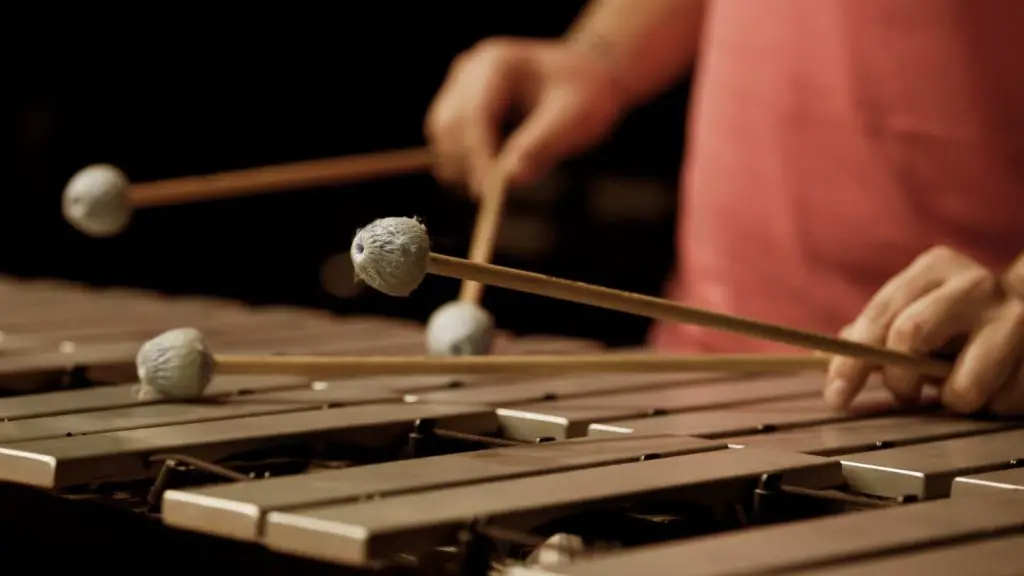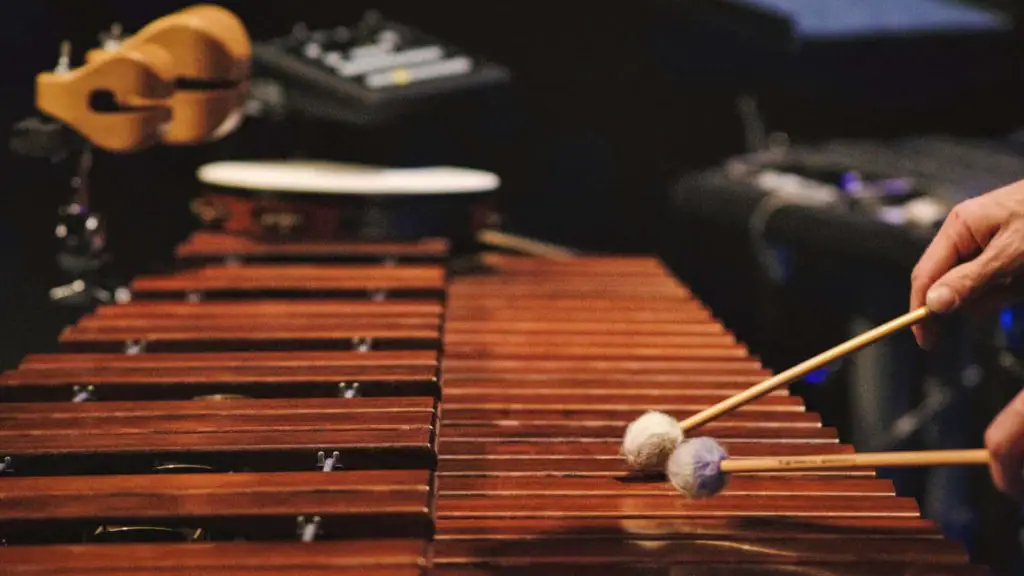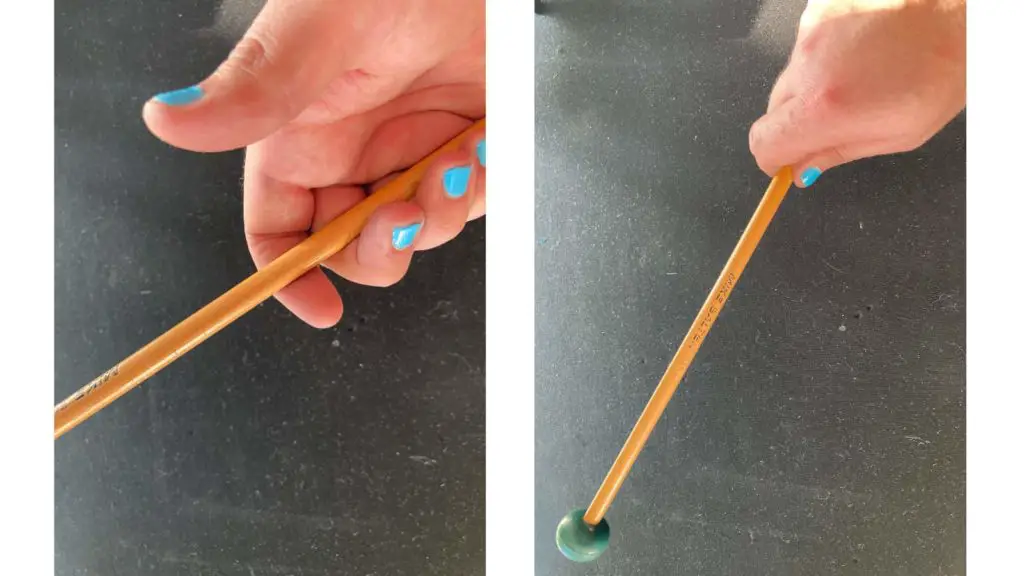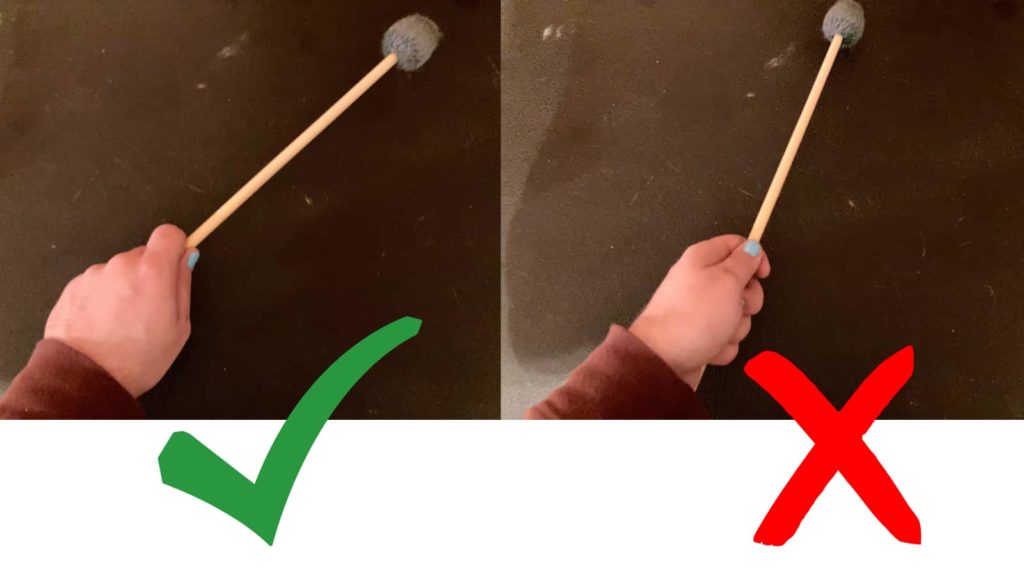The xylophone is a fantastic and often underrated instrument to play. Learning it teaches you most of what you would need to know to play any other keyboard instrument and doesn’t break the bank as a marimba or vibraphone would.
As a beginner xylophone player the first lessons you will learn are (1) how to hold your mallets with a two-mallet grip, (2) where to hit the keys, and (3) how to read the treble clef staff.
Learning the xylophone gives you access to a delightful mix of serious repertoire, meme sounds, and popular music. It’s also generally accepted that hitting stuff and getting to call it music is a good time.

Top Tip: If you aren’t sure what the difference between the xylophone, marimba, and vibraphone is, check out this article.
7 Instruments Similar to the Xylophone (With Video Samples)
Is Xylophone hard to Play?
I like to say to my students who ask this question. The short answer is “no,” and the longer answer is “yes.”
Producing sound on a xylophone is easy because all you have to do is hit a bar and it makes a characteristic sound, but learning to effectively perform on the xylophone does take time and energy like anything else.
When thinking about almost any other instrument there is a learning curve to making a characteristic sound.
Both brass and woodwind instruments require a good embouchure to make a noise at all, bowed-string instruments like violin require appropriate technique to make more than a scratchy sound, and even guitar or bass guitar requires you to push down the strings correctly to get any notes out.
Note: For an in-depth explanation on how sound is made with a Xylophone check out this article: How Sound Is Made on the Xylophone? (With Video Examples)
Percussion (which includes the xylophone) really only requires that you hit it in a general area for it to sound good. The xylophone is no exception to this. Even holding the mallets correctly isn’t too hard and the playing zones on xylophone keys have a pretty wide margin for error.
There are a few things about playing the xylophone that are a little tricky, though. It takes a fair amount of practice to consistently hit those playing zones while performing, particularly if the music has fast-moving passages.

Additionally, the way the notes are spread out makes it challenging to read the sheet music while playing. It’s fairly common for xylophone players to memorize their parts so they can more effectively keep an eye on where their hands are going.
This doesn’t mean that xylophone players struggle at sight-reading on their instrument, though. The more practice you have the more effective your muscle memory kicks in and guides you to the notes you want to hit even while you’re looking at a music stand.
🎵 Note: To find out why we think mastering the Xylophone can be the most difficult of all the percussion instruments read this article next: 6 of the Hardest Percussion Instruments to Learn
What is a Xylophone Player Called?
There are very few people who exclusively play the xylophone. You could call such a person a “xylophonist” or simply “xylophone player,” but people who play the xylophone are usually just called “percussionists.”
Typically someone who can play xylophone is competent on other percussion instruments and likely either did some ensemble in school or might have even studied it at the college level.
How to Play Xylophone for Beginners
3 Easy Steps to Start
- 1 how to hold your mallets
- 2 where to hit the keys
- 3 how to read the treble clef staff
Part three is covered in a later section entitled “How To Read Xylophone Music” which can be found by clicking here. So, let’s talk about the first 2.
How to hold your mallets with a two-mallet grip.
The grip you would use for xylophone mallets and the grip you would use for drumsticks are relatively similar but with some key differences. The weight of a drumstick is generally balanced more evenly across the stick while xylophone mallets are top-heavy.
Because of this balance difference, many xylophone players grip the mallet closer to the middle of the shaft rather than on the lower third as would be appropriate for a drumstick. Hold a xylophone mallet too far back and you may lose some control.
The shaft of your mallet should touch the pad of your thumb and the middle part of your index finger between your knuckles. Your remaining fingers should grip the shaft of the mallet firmly but comfortably.

Top Tip: Your pinkies are more important than you think. Don’t let them float away from the mallet.
While you are playing you want to use a wrist motion similar to knocking on a door.For the most part, you should be able to look down and see the back of your hand more so than your thumb. If you look down and see your thumb but can’t really see the back of your hand, you want to rotate your wrist to correct this.

Where To Hit The Keys
It is actually easier to answer this question by telling you where NOT to hit the keys. The spot on the bar that coincides with where the string runs through is what is called a “node” or “nodal point.” If you hit a key on one of these spots (there are two for each key) you will get a muted sound.
While the ideal striking location would be just off-center of the key, it will sound pretty good anywhere as long as you don’t hit a node. In fact, for more advanced pieces of music, it can often be better to hit on the edge of a bar to make fast sections easier to play.
Sometimes pieces of music will even call for you to hit the nodes on purpose so even that general rule is broken sometimes.
What are the notes on a Xylophone?
The notes on the xylophone are the same notes that you’d have on the piano but there are generally fewer of them. A 3-octave xylophone is going to have the same notes as the top 3 octaves of the piano (C5-C9).
The xylophone’s written range and sounding range are different, though. Xylophone notes sound an octave higher than written meaning that if your music tells you to play middle C (C4) then the note an octave higher (C5) is what will actually come out when you play. This is done to prevent the player from having to read too many ledger lines when they play.
How many notes are on a Xylophone?
This differs depending on the xylophone. It is relatively common to see 3-octave, 3.5-octave, and 4-octave xylophones with 3.5-octave being the most common. 5-octave xylophones do exist but are more rare
Each octave contains 12 notes so a 3-octave xylophone would have 36 notes. However, many xylophones end on C (what would be the start of the next octave) giving them 37 notes rather than 36.
A 3.5 octave goes down to an F below the 3-octave range so it would add 7 notes to your range (44), and 4-octaves ones would have 49 notes.
How to read Xylophone Music?
In Western music, there are only 7 letters in our musical alphabet: A, B, C, D, E, F, and G. With this in mind it is relatively easy to figure out what any note on a piece of music is as long as you have at least one other note to function as a reference.
Xylophone music is written on the treble clef staff. The treble clef staff has 5 lines and 4 spaces. The note names for the lines are E, G, B, D, F (from the bottom up) with the space note names being F, A, C, E.
Top Tip: If you can remember “face in the spaces” then figuring out the line notes becomes pretty easy.
Depending on the size of the xylophone you’ll have some notes below the staff that are on their own floating lines called “ledger lines.” If we’re counting downward, the first note below the staff would be D with the next one being C. That C hanging below the treble clef staff is commonly referred to as middle C.
If you feel pretty confident with basic rhythm then the two charts listed above can definitely give you a good start.
How Much Does Xylophone Cost?
There are a lot of things that will impact the price of a xylophone including whether it is wooden or synthetic, what the wood it is made of, whether or not it has resonators, whether or not it has a frame, how many octaves it has, what type of frame it has, and what brand you are buying.
A 3-octave kelon xylophone with no resonators and that sits on a stand is going to be significantly cheaper than a 4-octave rosewood professional model on a field frame.
But even with as many variables as the xylophone can have in pricing, there is still a general range that you can expect if you are considering buying one.
A practice xylophone that has no resonators is likely to cost you somewhere around $800. Once it starts getting much cheaper than that, quality assurance drops. If you wanted an instrument with a frame and resonators you’d be looking at a minimum of $1500.
And, quite honestly, $1500 would feel like a steal. Many of the respected brands start at $1600 and only go up.
How Much do Xylophone Lessons Cost?
Lessons on any instrument are going to vary in price depending on where you live. Typically geography has more to do with price than the instrument does. Taking a lesson in New York is going to cost something radically different than taking a lesson in Arkansas, for instance.
Most lessons are going to be either 30 minutes or an hour long and how that is charged depends on the teacher and/or business. Some people charge per lesson while others go for a monthly autopay. In general, though, you can expect to pay at least $30 per lesson and in some areas, it could be more.
Should I Learn to Play the Xylophone?
The simplest answer to this question is that you should learn the xylophone if it seems appealing to you. If you like it and want to play it, then go for it and don’t let anyone stop you. There are things worth considering about it, though.
First, while there is a lot of amazing music for xylophone you might find that opportunities to play it can be hard to come by. The demand for the instrument is a little low.
For instance, your local bar/venue is somewhat less likely to book your sick xylophone licks over a singer-songwriter doing acoustic covers of popular songs.
Second, the front-end cost can be a little much. On top of the expense, xylophones take up as much space as a small piece of furniture. It’s going to be around 4 feet long and 2 feet wide. So, it is an investment in money and space.
Third, it may be difficult to find a teacher in your area. Getting guitar lessons or piano lessons tends to be relatively easy in most areas. But finding someone who is proficient on xylophone is just going to be harder. It’s a music smaller pool of people.
All in all, though, percussion is fun. Keyboard percussion in particular can be really satisfying to play and it is something that others tend to enjoy listening to. So, if you want to learn, then go for it.
You can learn more by watching this video.
Up Next: Check our other articles about Xylophones
17 Songs with Xylophones In Them
7 Instruments Similar to the Xylophone (With Video Samples)
Disclaimer: This post may contain affiliate links. We only recommend high-quality products that are used and recommended by real musicians. If you use these links to buy something we earn a small commission.
